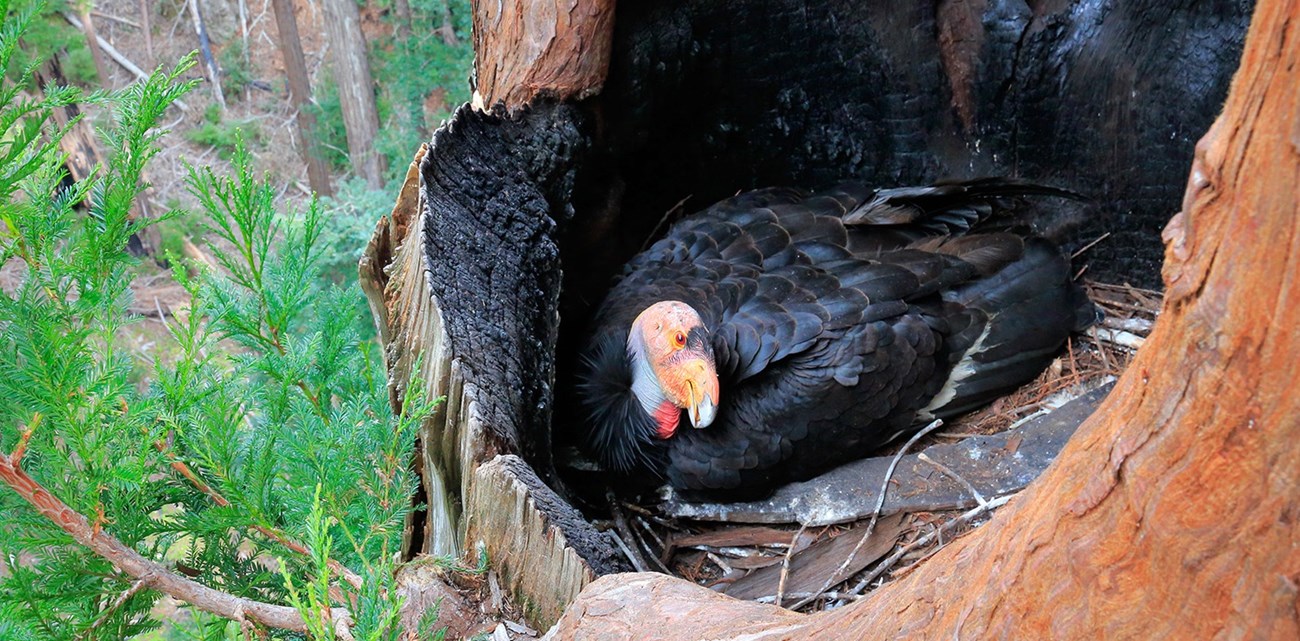
NPS/Gavin Emmons An Introduction to California CondorsScientific Name: Gymnogyps californianus Behavior and HabitatThese giants soar on wind thermals high above the ground, using their sharp eyesight to spot food below. As scavengers, they strictly eat carrion and have been observed feeding on everything from ground squirrels to beached whales. Condors require vast territories that provide ample food and shelter. They are capable of flying up to 200 miles in a single day, using their massive wings to glide long distances with minimal effort. Ideal habitat for condors includes:
Social NatureCondors are highly social birds, forming strong bonds with one another. They are playful and curious, often seen play fighting, preening each other, or gathering to inspect new objects they discover in their surroundings. These behaviors highlight their intelligence and adaptability, making them a fascinating species to observe in the wild. 
NPS/Gavin Emmons Condor ReproductionCalifornia Condors typically—though not always—form long-term bonds with one mate, year after year. Mated pairs begin the courtship process during the winter months, spending most of their time together, preening each other and inspecting potential nest sites. Male condors perform a display “dance” for their mate, after which the pair may copulate. Nesting and Egg LayingAfter several weeks or months of courtship, the mated pair selects a suitable nesting site. Unlike many other birds, condors do not build nests. Instead, they find cavities in rocky cliffs or large redwood trees. Between January and March, the female condor lays a single egg in the nest cavity. Both parents take turns incubating the egg for about two months until it hatches, after which they share the responsibility of raising their nestling for an additional six months until it fledges (learns to fly). Raising YoungFollowing the intensive parenting efforts at the nest, condor parents continue to care for their newly fledged offspring for up to another year. Due to the time and energy required to raise one chick to independence, condors only produce one young every two years. This slow reproductive rate makes California Condors particularly vulnerable to population declines from threats such as lead poisoning and other mortality events. Recovery from significant population losses is challenging and slow, emphasizing the importance of ongoing conservation efforts. 
NPS/Gavin Emmons Recovery Efforts for the California CondorThe California Condor once roamed a vast range, from British Columbia, Canada, down to Baja California, Mexico. However, this range significantly decreased as European settlers moved westward. Factors contributing to their decline included poisoning, shooting, habitat degradation, and the collection of eggs and feathers. By the late 1800s, naturalists noted the rapid decline in their numbers, leading to the species being listed as endangered in 1967. Despite these protections, the population continued to dwindle, reaching a critical low of just 22 individuals in the 1980s. To prevent extinction, all remaining wild condors were captured and placed in captive breeding programs. Captive Breeding and ReintroductionSince 1992, captive-bred condors have been released at five locations in western North America:
Each of these sites closely monitors the behavior, movements, nesting attempts, and survival of the condors. Pinnacles National Park joined the recovery effort in 2003, with its first release of two captive-bred condors on December 20th. A major milestone occurred in 2016 when the first condor chick since 1898 (condor 828) fledged from a nest within Pinnacles. Current Population Status and Ongoing ThreatsThanks to wild nesting and the continued release of captive-bred condors, their numbers have slowly increased. As of the end of 2018, there were 488 condors worldwide, with 312 of them flying free in the wild. Despite this progress, condors remain threatened by:
How You Can HelpCondors face many ongoing challenges, but there are ways you can support their recovery:
Every action taken contributes to the survival of these magnificent birds and helps protect other wildlife. Learn more about what you can do to aid the recovery of California Condors and other species at risk. |
Last updated: October 17, 2024
